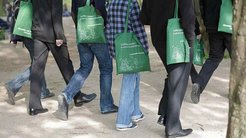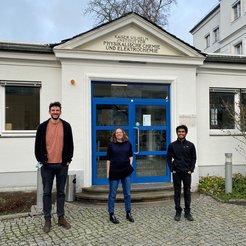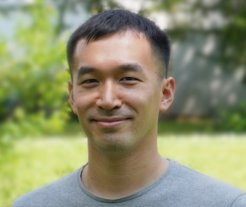Four new Humboldt Fellows at the Institute
This winter, four new scientists have joined the Fritz Haber Institute of the Max Planck Society with a Fellowship for Postdoctoral Researchers by the Humboldt Foundation. Despite the pandemic situation, the researchers coming from the United States, Italy and South Corea enjoy their stay at Berlin.

„The Humboldt Fellows are always an enrichment, we are very happy to have them here“, Prof. Martin Wolf, Managing Director of the Fritz Haber Institute, says. „It is very important to maintain the scientific and intercultural exchange also in these special times.“
Dr. David Mathai Koshy (Interface Science Department, Humboldt Fellow since November 2021)
I obtained my BS in Chemical Engineering from UC Berkeley and my PhD in Chemical Engineering from Stanford University. The focus of my doctoral work was investigating the CO2 reduction active sites of carbon-based materials using electrochemical and chemical characterization techniques. I chose to do my postdoc at FHI because I wanted to expand my background in catalysis by learning surface science, a field of research that uses well-defined model systems to understand catalytic activity. FHI is world renowned for surface science and I am interested in leveraging this expertise in sample preparation and characterization towards new scientific challenges. My specific research goal is to further develop and utilize surface action spectroscopy, a new surface characterization technique developed at FHI, which can provide structural information about the top layer of atoms on a catalyst surface. I'm really excited to work with Dr. Helmut Kuhlenbeck and Prof. Beatriz Roldan Cuenya on this research topic which can help us learn more about the atomic structure of catalysts that are relevant for renewable technologies.

Dr. Mallory Green (Molecular Physics, since December 2021)
I am originally from sunny Florida in the USA. However, I conducted my undergraduate and graduate studies in the state of Georgia. As an undergraduate, I did computational astrochemistry research, where I modeled potential anions that could be found in the interstellar medium. Moving into my PhD, I transitioned to more experimental work on anions. I used velocity map imaging spectroscopy to study small gas-phase beryllium-containing anions, which are of interest due to the element's very unique chemical properties. About a year and a half ago, I started as a postdoctoral researcher at the FHI. Using my knowledge of velocity map imaging and anions, I have worked on a project that aims to distinguish anionic enantiomers using photoelectron circular dichroism. My Humboldt Fellowship project entails constructing a new velocity map imaging spectrometer, which is specifically built to work with the radiation of the FEL. The goal of this proposed machine is provide a way to study weakly-bound anions, starting with the non-valence anionic states of xenon clusters.
Dr. Giacomo Valtolina (Molecular Physics, since December 2021)
In 2016, I completed my PhD at Scuola Normale Superiore, working in Massimo Inguscio's group at LENS - Florence on quantum simulation with ultracold Fermi gases. After, I moved to JILA - University of Colorado, Boulder as a postdoc in Jun Ye's group. There, we realized the first quantum degenerate Fermi gas of polar molecules. At the FHI, I am leading the construction of a new ultracold molecule experiment for realizing a Bose-Einstein condensate of polar molecules an investigate new regimes in ultracold quantum chemistry.
Dr. Hyunwook Jung (Theory Department, from February 2022)

I'm from Korea and I finished PhD from chemical engineering department in Yonsei university. I previously worked on reaction mechanism elucidation for hazardous chemicals when I was PhD student. Here in FHI, I'm working on finding reaction mechanism in heterogeneous surface catalysis. To be more specific, I'm focused on syngas conversion which involves particularly complicated reaction intermediates which has not been fully clarified up to date. Understanding reaction mechanism will help us to model better catalyst material and process. I use graph method and machine learning based on first-principles calculation to solve this problem.
Every year, the Alexander von Humboldt Foundation enables more than 2,000 researchers from all over the world to spend time conducting research in Germany. So far more than 30,000 fellowships have been awarded across all disciplines to researchers from more than 140 countries worldwide – including 55 Nobel Laureates. In 2020, a total of 955 (out of 3131) applications from researchers from abroad were approved. The Fritz Haber Institute hosted a total of 44 researchers (32 fellows and 12 award winners) in the years from 2016 to 2020. This means that the FHI "hosts" the most Humboldt researchers in Berlin behind the major universities (FU, HU, TU).


